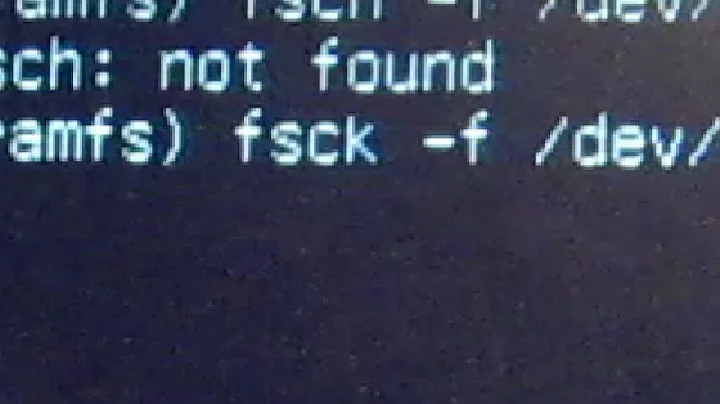Mount root filesystem from initramfs
Solution 1
exec switch_root /mnt/root /sbin/init
https://wiki.gentoo.org/wiki/Custom_Initramfs#Init
Solution 2
It depends on the kind of problem, if the problem was borking the initramfs image itself then you'll need to actually regenerate it (run update-initramfs) to fix things. Remember the initramfs file system is a RAM filesystem, so to fix anything you need to fix the compressed initramfs image and/or fix the root filesystem.
I've used the following procedure on an LUKS encrptyed Ubuntu system in order to resume a boot broken by a bad crypttab.
First, I decrypted the partition
cryptsetup luksOpen /dev/nvme0n1p3 nvme0n1p3_crypt
Note the device_crypt isn't random. It needs to match the name that's normally used when your system mounts (partition + _crypt seems to be standard).
Next, you need to activate the Volume Groups on that now-decrpyted partition.
vgchange -ay
Now, you can try mounting the file systems, /, /boot, proc, swap, etc, and getting things running that way.
Though in my case all I had to do was type exit and initramfs saw the logical volumes sitting there and happily resumed the boot. At that point it was easy to fix the damange and run update-initramfs -u
Solution 3
Simply run fsck command without options from initramfs then reboot
eg: the root partition is sda3
fsck /dev/sda3
Solution 4
If the root= parameter is correct and the issue is just that the necessary device isn't available (for example because the initramfs failed to assemble an md RAID), then it's enough to make the device available manually, for example:
mdadm --assemble ...
Then check that the device is there and if everything looks good, hit ctrl + d or type exit to quit the initramfs shell. The initramfs will then mount the root filesystem and continue to boot as usual. After the system has booted, you should then repair the underlying issue, for example by running update-initramfs -u.
I haven't yet found a way to tell the initramfs to boot a different device than what /proc/cmdline says. Maybe someone else has an idea?
Solution 5
normal procedure is
- mount /dev/sdX /mnt
- fix problem on /mnt
- reboot
You might want to
- mount /dev/sdX /mnt
- fix /mnt
- umount /mnt
- mount /dev/sdX /
- finish boot manualy
This is not recommended, you'll have to do it on every boot. In a production environment, you can't be sure manual boot follow same steps as automatic one.
However in a emergency with critical data, step 5 usualy boil down to:
- 5.1 set up network
- 5.2 copy important file to safe place
Related videos on Youtube
MathematicalOrchid
Updated on September 18, 2022Comments
-
MathematicalOrchid over 1 year
It's a common scenario. For whatever reason, the initramfs (OpenSUSE, in case it matters) has failed to find the root filesystem, so it drops you into a rescue shell. I know perfectly well what device needs to be mounted though. My question:
What is the correct procedure to mount the root filesystem and continue the boot sequence?
Presumably that's the whole point of the rescue console. And yet, nobody seems to have documented how you actually do this.
Obviously I can mount the root filesystem somewhere. But how do I make that the root of the filesystem tree? And now do I continue the normal boot process after that? (I thought just exiting the shell would do it... but it doesn't.) What exactly do you need to get mounted before you continue, and how do you continue?
-
Eric Renouf almost 8 yearsI could be wrong, but I think once you're in a rescue shell you can't continue the current boot, you fix things so the next boot will succeed
-
 Martin von Wittich almost 8 years@EricRenouf manually booting the full system may very well be the easiest way to fix such an issue. I had problems in the past where the initramfs failed to open my cryptsetup-luks encrypted root partition, and the easiest fix was to manually boot it and then run
Martin von Wittich almost 8 years@EricRenouf manually booting the full system may very well be the easiest way to fix such an issue. I had problems in the past where the initramfs failed to open my cryptsetup-luks encrypted root partition, and the easiest fix was to manually boot it and then runupdate-initramfs -u. I absolutely couldn't get it working when I justchrooted into the root filesystem from a rescue system; the resulting initramfs was always broken. -
 Gilles 'SO- stop being evil' almost 8 yearsIs it actually an initrd, or an initramfs? (Just because the file is called
Gilles 'SO- stop being evil' almost 8 yearsIs it actually an initrd, or an initramfs? (Just because the file is calledinitrddoesn't mean that it's one: most distributions have switched toinitramfsbut keep calling the fileinitrd.) What distribution are you using (as what the initrd/initramfs does depends on what the distribution put there)? -
MathematicalOrchid almost 8 years@Gilles I'm pretty sure it's actually initramfs. Not sure if it actually makes a difference though; either way, I've got a mini filesystem and I need to mount the real filesystem. (OpenSUSE, in case it matters.)
-
-
 user2121874 over 6 yearsI believe the "actual" question of the original poster was "How exactly do you do '5. finish boot manualy'?"
user2121874 over 6 yearsI believe the "actual" question of the original poster was "How exactly do you do '5. finish boot manualy'?" -
jaam about 5 yearsThe reboot just dropped me to grub shell instead of initramfs shell. Now I'll do everything over again to get to initramfs shell
-
 janh almost 4 yearsThis worked for me.
janh almost 4 yearsThis worked for me.rebootdidn't do anything, but simply runningexitafter completing the checks continued the booting process, now with a good file system. -
Vishal K almost 3 yearsI had a similar problem running fsck give clean. But I still won't able to boot normally.




